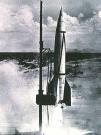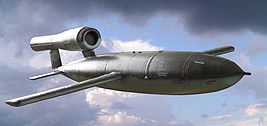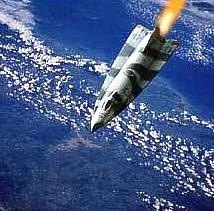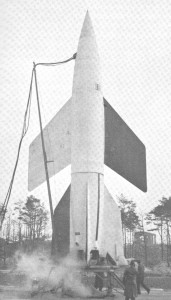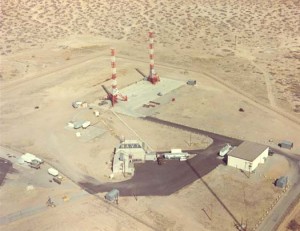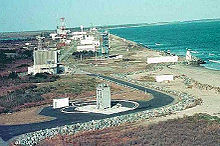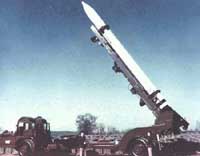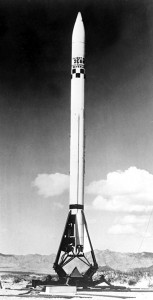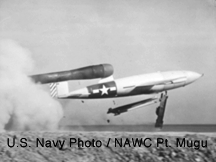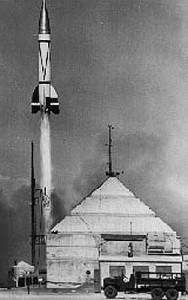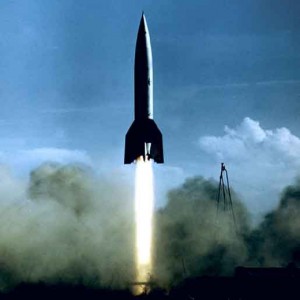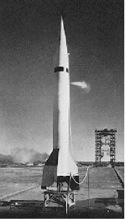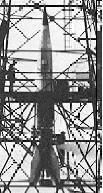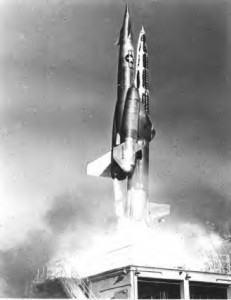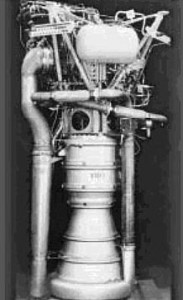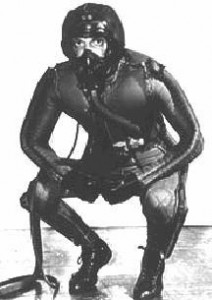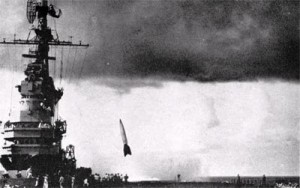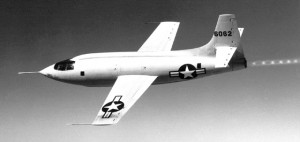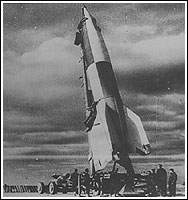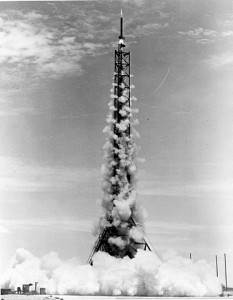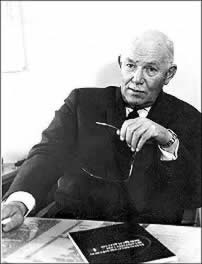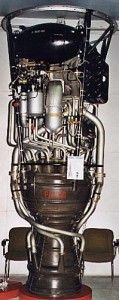December 7: Pearl Harbor is attacked, bringing the US into World War II.
June 13: The first launching attempt was made with the A-4 (V-2) rocket at Peenemunde. It reached an altitude of only 0.8 miles. The V-2 missile was 47 ft tall, weighed 28,000 pounds, had a range of 200 miles with a trajectory height of 60 miles, and a speed of 3300 mph at burnout. The engine generated 56,000 lb of thrust and burned LOX and EtOH.
 German V2 Rocket Launch Failures (5.8 MiB)
German V2 Rocket Launch Failures (5.8 MiB)
 1944 V2 (3.5 MiB)
1944 V2 (3.5 MiB)
 1944 V-2 (9.2 MiB)
1944 V-2 (9.2 MiB)
 V-2 Rocket (3.2 MiB)
V-2 Rocket (3.2 MiB)
 V-2 Rocket Facility At Peenemunde (19.7 MiB)
V-2 Rocket Facility At Peenemunde (19.7 MiB)
 German V-2 Launch List (103.4 KiB)
German V-2 Launch List (103.4 KiB)
October 3: The third V-2 launched climbed 30 miles and traveled to a point 118 miles from Peenemunde, this was credited as the first successful flight. Gen. Dr. Walter Dornberger, after watching the launch, remarked “The age of spaceflight has arrived”.
May-June: The Germans conducted operational tests of the V-2 rocket by firing over 100 from Blizna against Sarnaki, Poland, including 10 launches on 1 day.
August 17: The British carried out a saturation air raid on the Peenemunde rocket development center in Germany.
November: Theodore von Karman of the Jet Propulsion Laboratory (JPL) recommended to Army Ordnance the development of a long-range surface-to-surface missile.
March 15: Dr. Wernher von Braun was arrested by the S.S. for over-concentration on space travel rather than military missile problems. He was later released on the grounds that his services were indispensable.
June 13: The first V-1 missile was launched from the Pas de Calais to exploded in the center of London. The V-1 missile had a speed of 400 miles per hour and a range of
190 miles.
June: A V-2 missile from Peenemunde overshot the Baltic and landed in Sweden where the remains were collected and flown to England for analysis.
June: The first suborbital space flight by the international definition (greater than 100 km) occurred when a V-2 test rocket launched from Peenemunde in Germany reached 175 km (109 mi) altitude. Some records give the highest altitude V-2 flight as 189 km (117 miles) on September 14, 1944.
September 8: The first V-2 falls on Paris and London. From this time on until March 1945 when the launch sites were over-run by the Allies, 1,027 V-2’s were launched from the vicinity of The Hague, with 92.3 percent launched successfully. Of the total number fired from all sites toward Britain, there were about 1,300 fired at London and 40 at Norwich. 518 fell in the London Civil Defense Region, and none at Norwich. The results in London were 2,511 persons killed and 5,869 seriously wounded. 5200 V-2 s were produced and 3172 were successfully launched.
November 15: U.S. Army Ordnance began the Hermes program of research and development on ballistic missiles.
January 24: The Germans successfully launched a winged version of the V-2, the A-9, designed to be the upper stage of an ICBM for an ultimate attack on North America. It reached an altitude of 50 miles with a speed of 2,700 miles per hour.
February 20: The White Sands Proving Ground was established in New Mexico.
May 8: Formal surrender of Germany.
July 4: The first test rocket was launched at the Auxiliary Flight Research Station, Wallops Island, Virginia.
July 16: First atomic bomb detonated at the Trinity site in New Mexico.
July 23: Life magazine published detailed drawings of a large manned space station, including a large space mirror, as envisioned by the German scientists of Peenemunde.
August 6: Atomic bomb is dropped over Hiroshima.
August: Components for approximately 100 V-2 weapons were shipped from Germany to White Sands, New Mexico.
September 2: Formal surrender of Japan, ending World War II.
September 26: In the first development flight of an Army Wac-Corporal surface to surface missile, an altitude of 43.5 miles was reached. Aerojet developed this small rocket (700 pounds).
September: Over the next 6 months, 127 rocket scientists are brought over to the U.S. from Germany as part of Operation Paperclip, including Dr. Werner von Braun and Dr. Hubertus Strughold, to work on U.S. rocket development (initially temporarily, but most eventually obtained permanent U.S. citizenship). Among the leaders of the group who came to the USAF School of Aviation Medicine at Randolph Field, Texas were Dr. Hubertus Strughold, Dr. Heinz Haber, Dr. Ulrich Luft, Dr. Fritz Haber, Dr. Hans-Georg Clamann, Dr. Konrad Buettner and Dr. Siegfried J. Gerathewohl. Dr. Otto Gauer, Dr. V. K. Henschke and others went to the Aeromedical Laboratory, Wright-Patterson Air Force Base, Ohio. Dr. Hermann Schaefer, Dr. D. Beischer and others went to the Naval School of Aviation Medicine at Pensacola, Florida.
 Operation Paperclip (99.5 KiB)
Operation Paperclip (99.5 KiB)
September: A large number of German rocket engineers, including Helmut Grottrup, are deported to the USSR to work on rocket development.
January 26: The Army Air Force created the First Experimental Guided Missiles Group at Eglin Field, Fla.
January: The first missile was launched at the Naval Air Facility, Point Mugu, Calif. This was the Loon, which was patterned after the German V-1.
April 16: The first German V-2 in the U.S. was launched at White Sands, N.M. 71 V-2 launches would be carried out at White Sands with the last one on September 19, 1952. Success rate was 68%.
 V-2 White Sands (1.2 MiB)
V-2 White Sands (1.2 MiB)
 US V-2 Launch List (19.3 KiB)
US V-2 Launch List (19.3 KiB)
 1946 V2 In US (3.2 MiB)
1946 V2 In US (3.2 MiB)
April 19: The Army Air Force started Project MX-774 with Consolidated-Vultee to study rocket designs that would lead to an ICBM.
April 22: A contract was placed with North American Aviation to develop the Navaho winged rocket missile with a range up to 500 miles. In March 1948 this was redesigned as a ramjet propelled missile. It never reached operational status. The large liquid fueled rocket engine (XLR-43-NA-1) that was to boost it to ramjet speed later provided the basic engine used in the Thor, Jupiter, Atlas, and Saturn rockets.
May 10: The first suborbital U.S. V-2 flight achieved an altitude of 112.6 km (70.0 mi).
May 12: Project Rand presented its report to the Army Air Force entitled “Preliminary Design of an Experimental World-Circling Space Ship,” which described the technical feasibility of building and launching an artificial satellite. They stated, “A satellite vehicle with appropriate instrumentation can be expected to be one of the most potent scientific tools of the Twentieth Century”.
Read the report at:
 Rand (3.8 MiB)
Rand (3.8 MiB)
August 6: Two unmanned B-17 drones flew from Hilo, Hawaii to Muroc AirBase, California, demonstrating the possibility of accurate long-range guided missiles armed with atomic warheads.
October 24: March 20: The first photograph made at an altitude of 100 miles was made following a V-2 test at White Sands, N.M.
 First Photo Space V-2 13 (40.3 KiB)
First Photo Space V-2 13 (40.3 KiB)
 V-2 -21 California 030747 (33.6 KiB)
V-2 -21 California 030747 (33.6 KiB)
December 17: A program of space biology was initiated at Holloman AFB, New Mexico by the National Institutes of Health.
 History Of Holloman AFB Space Biology (13.3 MiB)
History Of Holloman AFB Space Biology (13.3 MiB)
1946: Dr. Heinz Haber discussed the problems that were to be encountered with adaptation to weightlessness during space flight in a seminar at the USAF Aeromedical Center in Heidelberg, Germany.
During the year, the Signal Corps bounced radio signals against the Moon, proving that relatively low power could transmit signals over great distances.
During the year, the David Clark Company produced a partial pressure suit (T-1, S-1, S-2) for use in the X-1.
January 23: A V-2 at White Sands carried telemetry successfully for the first time and climbed to an altitude of 31 miles.
February 20: For the first time, a V-2 at White Sands ejected a canister for parachute recovery of fruit flies and corn seeds exposed to cosmic rays, after a climb to 68 miles. Several subsequent V-2 flights carried additional biological samples, including moss.
May 27: The first Army Corporal E surface-to-surface rocket was launched.
July 1: The MX-774 contract with Convair to develop ballistic missiles was cancelled by the Army Air Force. However, the company decided to pursue the work with its own funds, ultimately leading to the Atlas ICBM.
September 6: A V-2 missile was fired from the deck of the USS Midway near Bermuda.
September 22: A United States Air Force C-54 made an automatic flight across the Atlantic from Stephenville, Newfoundland to Brise Norton, England. The crew on board had absolutely nothing to do except to monitor the operation of the automatic guidance and flight system.
October 7: Based upon infrared spectroscopic studies performed at the McDonald Observatory in Texas, Gerard P. Kuiper determined that carbon dioxide was a major component of the Martian atmosphere with a pressure of 2 millibars (actually now known to be 6 millibars). Occultation studies indicated that the atmospheric pressure was 80 milibars (actually now known to be only 6 millibars) that would make it very thin (8% of Earth’s, but now known to be 0.6% of Earth’s). It was assumed that the rest of the atmosphere was composed of spectroscopically inert nitrogen and argon.
October 14: Capt. Chuck Yeager is the first to break the sound barrier. He passes Mach 1.06 (807.2 mph) in the Bell X-1 (powered by the XLR-11 engine with 5000 lbs thrust) on Flight #50 at Muroc Army Air Field (later Edwards AFB).
October 18: The first Soviet V-2 was launched from Kapustin Yar.
 Soviet V-2 Launch List (3.0 KiB)
Soviet V-2 Launch List (3.0 KiB)
November 24: The first complete Aerojet (developed by von Karman) Aerobee rocket was flown to a height of 37 miles at White Sands, New Mexico. It was an expansion of the Wac-Corporal. A large number – 1,037 of different variants of Aerobee launches were carried out with the last one on January 17, 1985.
Aerobee 2600-pound thrust, 150-pound payload, 60-mile altitude
Aerobee-Hi 4000-pound thrust, 150-pound payload, 150-mile altitude
In 1947: Dr. Vasily Parin was arrested by Stalin and imprisoned for the next five years. After Stalin’s death in 1953, he was released and became the director of biomedical and medical research in charge of selection, training and monitoring of all cosmonauts. He was responsible for all medical aspects of the manned space flight programs of the USSR from 1956 until 1971. He was the Director of the Institute of Biomedical Problems (IBMP) from 1965-69. He was also the founder and editor-in-chief or the USSR Journal of Space Biology and Medicine.
During the year, “German Aviation Medicine in World War II”, which was a summary of knowledge from the German aerospace medical community, was published by the USAAF and edited by Dr. Hubertus Strughold. It was authored by 56 aviation medical specialists and greatly advanced aerospace medicine. The first article ever published on space medicine was written in this book: “Man under Gravity Free Conditions” by Heinz Haber and O. Gauer.
Ref – Gauer O., Haber H.: Man under Gravity-Free Conditions. In: German Aviation Medicine World War II; Chapter VI, S. 641-4. US Department of the Air Force, U.S. Govt. Print. Office, Washington 1950.
January 15: Gen. H. S. Vandenberg, Vice Chief of Staff, USAF, approved a policy calling for the development of Earth satellites.
February 6: The Army achieved successful electronic guidance of a V-2 missile at White Sands, in a climb to an altitude of 70 miles.
May 13: The first Project Bumper shot was made at White Sands. This was a two-stage combination of a V-2 German rocket carrying a second stage American Wac-Corporal. On this flight an altitude of 79.1 miles was reached.
 White Sands Bumper (105.8 KiB)
White Sands Bumper (105.8 KiB)
June 11: Beginning on this date, several USAF Aeromedical Laboratory biomedical V-2 launches (the flight profile was 30 secs of 4-5 G followed by 150 secs of 0 G) were made from White Sands, New Mexico as summarized:
– June 11, 1948: A V-2 was launched at White Sands carrying an anaesthetized rhesus monkey, Albert I, to an altitude of 206,000 ft, but he died of suffocation.
– June 14, 1948: A V-2 flight at White Sands carried another anaesthetized rhesus monkey, Albert II, to a height of 428,000 ft. The monkey survived the flight, but was killed when his compartment impacted.
– September 16, 1949: A V-2 carrying a cynomolgus monkey, Albert III, exploded at 35,000 ft.
– December 8, 1949: The rhesus monkey Albert IV was launched with biomedical monitoring and suffered no ill effects from a V-2 flight to 425,000 ft until the moment of impact at White Sands.
– August 31, 1950: A mouse was launched in a V-2 to 450,000 ft in which behavior was photographed in-flight and recovered (the biological payload did not survive impact).
Animals in Spaceflight.mp4
July 14: The first Convair MX -774 missile was test fired at White Sands. It weighed 2800 lbs and had a thrust of 7900 lbs. Three launches over the next 18 months resulted in three failures.
 MX-774 Launch List (1.0 KiB)
MX-774 Launch List (1.0 KiB)
September 14: Professor E. P. Wigner discussed the application of nuclear energy to space propulsion.
September 15: The Committee on Guided Missiles of the Research and Development Board recommended that the Army Hermes project provide a continuing analysis of problems related to the development of an Earth satellite.
September 15: First launch of a Soviet R-1 (a copy of the V-2) at Kasputin Yar. The RD-100 engine (designed by Glushko) burned EtOH/LOX and had a thrust of 68,000 lbs.
 R-1 Launch List (37.4 KiB)
R-1 Launch List (37.4 KiB)
November 6: Dr. H. Tsien at California Institute of Technology described
a design for a nuclear powered space ship.
 H S Tsien (3.7 MiB)
H S Tsien (3.7 MiB)
November 10: Col. Harry G. Armstrong, M.D. organized a panel discussion on the “Aeromedical Problems of Space Travel.” This first Symposium on Space Medicine was held at the USAF School of Aviation Medicine at Randolph Field, San Antonio. It featured papers by Dr. Armstrong, Dr. Hubertus Strughold and Dr. Heinz Haber as well as commentary by several well-known scientists from universities and the military. This symposium marked the beginning of formal, academic inquiry into the medical hazards of extra-atmospheric flight. Strughold resolved the contradiction inherent in the title of the symposium by emphatically using the term “space medicine” for the first time. Dr. Strughold predicted that the main medical problems of spaceflight could be formulated and the majority of the questions fully answered within 10 to 15 yr. Hardware could be developed within 15 to 20 yr. The first manned spaceflights thus would become feasible between 1964 and 1969.
December 29: The First Report of the Secretary of Defense, James Forrestal, reported that the United States had been engaged in research on an Earth satellite. The Report of the Executive Secretary of the Research and Development Board, contained as
an appendix, stated :
“The Earth Satellite Vehicle Program, which was being carried out independently by each military service, was assigned to the Committee on Guided Missiles for coordination. To provide an integrated program with resultant elimination of duplication, the committee recommended that current efforts in this field be limited to studies and component designs; well-defined areas of such research have been allocated to each of the three military departments.”


